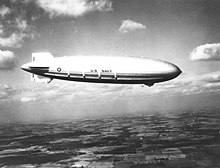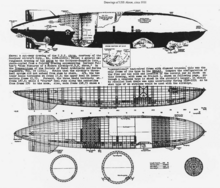
An airship, dirigible balloon or dirigible is a type of aerostat (lighter-than-air) aircraft that can navigate through the air flying under its own power. Aerostats use buoyancy from a lifting gas that is less dense than the surrounding air to achieve the lift needed to stay airborne.
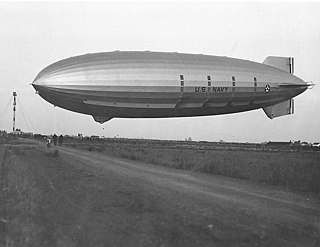
USS Akron (ZRS-4) was a helium-filled rigid airship of the U.S. Navy, the lead ship of her class, which operated between September 1931 and April 1933. It was the world's first purpose-built flying aircraft carrier, carrying F9C Sparrowhawk fighter planes, which could be launched and recovered while it was in flight. With an overall length of 785 ft (239 m), Akron and her sister ship Macon were among the largest flying objects ever built. Although LZ 129 Hindenburg and LZ 130 Graf Zeppelin II were some 18 ft (5.5 m) longer and slightly more voluminous, the two German airships were filled with hydrogen, and so the two US Navy craft still hold the world record for the largest helium-filled airships.

USS Shenandoah was the first of four United States Navy rigid airships. It was constructed during 1922–1923 at Lakehurst Naval Air Station, and first flew in September 1923. It developed the U.S. Navy's experience with rigid airships and made the first crossing of North America by airship. On the 57th flight, Shenandoah was destroyed in a squall line over Ohio in September 1925.

USS Los Angeles was a rigid airship, designated ZR-3, which was built in 1923–1924 by the Zeppelin company in Friedrichshafen, Germany, as war reparations. She was delivered to the United States Navy in October 1924 and after being used mainly for experimental work, particularly in the development of the American parasite fighter program, was decommissioned in 1932.

USS Macon (ZRS-5) was a rigid airship built and operated by the United States Navy for scouting and served as a "flying aircraft carrier", carrying up to five single-seat Curtiss F9C Sparrowhawk parasite biplanes for scouting or two-seat Fleet N2Y-1s for training. In service for less than two years, the Macon was damaged in a storm and lost off California's Big Sur coast in February 1935, though most of the crew were saved. The wreckage is listed as the USS Macon Airship Remains on the U.S. National Register of Historic Places.

A parasite aircraft is a component of a composite aircraft which is carried aloft and air launched by a larger carrier aircraft or mother ship to support the primary mission of the carrier. The carrier craft may or may not be able to later recover the parasite during flight.

A hangar is a building or structure designed to hold aircraft or spacecraft. Hangars are built of metal, wood, or concrete. The word hangar comes from Middle French hanghart, of Germanic origin, from Frankish *haimgard, from *haim and gard ("yard"). The term, gard, comes from the Old Norse garðr.
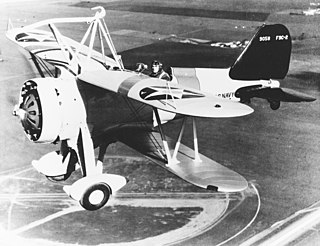
The Curtiss F9C Sparrowhawk is a light 1930s biplane fighter aircraft that was carried by the United States Navy airships USS Akron and Macon. It is an example of a parasite fighter, a small airplane designed to be deployed from a larger aircraft such as an airship or bomber.
An airborne aircraft carrier is a type of mother ship aircraft which can carry, launch, retrieve and support other smaller parasite aircraft. The only dedicated examples to have been built were airships, although existing heavier-than-air aircraft have been modified for use in similar roles.
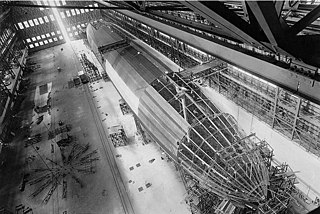
A rigid airship is a type of airship in which the envelope is supported by an internal framework rather than by being kept in shape by the pressure of the lifting gas within the envelope, as in blimps and semi-rigid airships. Rigid airships are often commonly called Zeppelins, though this technically refers only to airships built by the Luftschiffbau Zeppelin company.

Sometimes dubbed the Golden Age of Aviation, the period in the history of aviation between the end of World War I (1918) and the beginning of World War II (1939) was characterised by a progressive change from the slow wood-and-fabric biplanes of World War I to fast, streamlined metal monoplanes, creating a revolution in both commercial and military aviation. By the outbreak of World War II in 1939 the biplane was all but obsolete. This revolution was made possible by the continuing development of lightweight aero engines of increasing power. The jet engine also began development during the 1930s but would not see operational use until later.

Hangar No. 1 is an airship hangar located at Naval Air Engineering Station Lakehurst in Manchester Township, in Ocean County, New Jersey, United States. It was the intended destination of the rigid airship LZ 129 Hindenburg prior to the Hindenburg disaster on May 6, 1937, when it burned while landing. Built in 1921, it is one of the oldest surviving structures associated with that period's development of lighter-than-air flight. It was designated a National Historic Landmark in 1968.
Airship hangars are large specialized buildings that are used for sheltering airships during construction, maintenance and storage. Rigid airships always needed to be based in airship hangars because weathering was a serious risk.

The two Hindenburg-class airships were hydrogen-filled, passenger-carrying rigid airships built in Germany in the 1930s and named in honor of Paul von Hindenburg. They were the last such aircraft to be constructed, and in terms of their length, height, and volume, the largest aircraft ever built. During the 1930s, airships like the Hindenburg class were widely considered the future of air travel, and the lead ship of the class, LZ 129 Hindenburg, established a regular transatlantic service. The airship's destruction in a highly publicized accident was the end of these expectations. The second ship, LZ 130 Graf Zeppelin, was never operated on a regular passenger service, and was scrapped in 1940 along with its namesake predecessor, the LZ 127 Graf Zeppelin, by order of Hermann Göring.
The static buoyancy of airships in flight is not constant. It is therefore necessary to control the altitude of an airship by controlling its buoyancy: buoyancy compensation.

Thomas Greenhow Williams "Tex" Settle was an officer of the United States Navy who on November 20, 1933, together with Army major Chester L. Fordney, set a world altitude record in the Century of Progress stratospheric balloon. An experienced balloonist, long-time flight instructor, and officer on the airships USS Shenandoah (ZR-1) and USS Los Angeles (ZR-3), Settle won the Litchfield Trophy in 1929 and 1931, the International Gordon Bennett Race in 1932, the Harmon Aeronaut Trophy for 1933, and the Harmon National Trophy for 1932 and 1933. He also set numerous distance and endurance records.
The ZRCV was a large dirigible aircraft carrier proposed by the Lighter-than-Air Bureau of the United States Department of the Navy and the Goodyear-Zeppelin Corporation. It would have been a 9.55-million-cubic-foot (270,000 m3) airship designed to carry nine Douglas-Northrop BT–1 dive bombers.
In the nation's quest to provide security along its lengthy coastlines, air reconnaissance was put forth by the futuristic Rear Admiral William A. Moffett. Through his efforts, two Naval Air Stations were commissioned in the early 1930s to port the Naval Airships (dirigibles) which he believed capable of meeting this challenge.
Unlike later blimp squadrons, which contained several airships, the large rigid airship units consisted of a single airship and, in the case of the USS Akron and USS Macon, a small contingent of fixed-wing aircraft.


